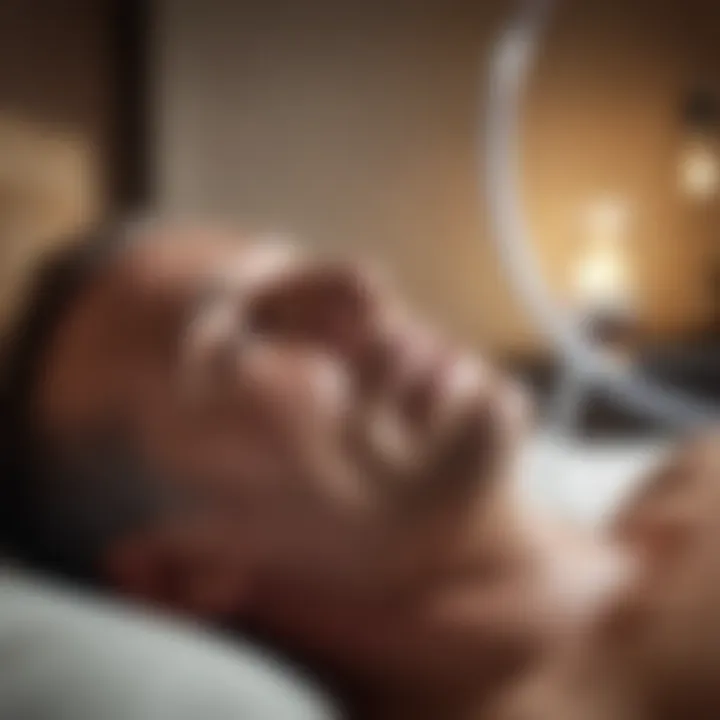Comprehensive Guide to Home Oxygen Therapy


Intro
Home oxygen therapy isn’t just a medical buzzword—it’s a lifeline for many individuals struggling with respiratory challenges. For those who face the daily grind of low oxygen levels, having access to supplemental oxygen can be life-changing. It connects the dots between feeling fatigued and finding the energy to engage with life.
This therapy supports a range of conditions from chronic obstructive pulmonary disease (COPD) to pulmonary fibrosis, guiding patients back to a semblance of normalcy. By analyzing the purpose and the devices employed in home oxygen therapy, this article intends to highlight its significance.
Understanding the criteria that determine patient eligibility and the clinical guidelines surrounding its administration is crucial for both practitioners and patients. Moreover, we’ll also investigate the physiological impacts of added oxygen, how to manage therapy effectively, and discuss potential risks.
So buckle up, as we delve into the nitty-gritty of home oxygen therapy and unravel its complexities.
Defining Home Oxygen Therapy
Home oxygen therapy stands as a pivotal component in the management of various respiratory conditions. This intervention aims to augment the oxygen supply in patients whose natural breathing does not suffice to maintain adequate levels in the bloodstream. When oxygen saturation dips too low, it can lead to numerous complications, potentially affecting the function of vital organs and overall quality of life. Defining home oxygen therapy goes beyond simply measuring oxygen levels; it encompasses understanding its implications, applications, and benefits.
Historical Context
The roots of oxygen therapy trace back to the early 19th century, when scientists began to grasp the essential role of oxygen in human physiology. Initially, oxygen was a luxury reserved for hospitals, just like a fine wine is for special occasions. However, as knowledge expanded, so did the approaches to treating patients with respiratory insufficiencies.
World War II accelerated the development of medical technologies, leading to innovations in how oxygen could be delivered. By the 1960s, the concept of providing oxygen at home emerged, changing the landscape of respiratory care. This shift recognized the need for patients with chronic obstructive pulmonary disease (COPD) and other ailments to receive therapy within the comfort of their homes, allowing for increased engagement in their own health and a better quality of life. The evolution of home oxygen therapy reflects a gradual but significant change, from hospital-bound interventions to a more personal, patient-centered model.
Modern Applications
Today, the relevance of home oxygen therapy is more pronounced than ever. Tailored for a variety of conditions including asthma, pulmonary hypertension, and cystic fibrosis, the therapy holds potential to transform lives. Patients don’t just receive oxygen; they receive a renewed sense of agency over their health.
Modern applications can take many forms, utilizing advanced technologies to ensure effectiveness. For instance, portable oxygen concentrators have allowed for mobility, offering patients the freedom to engage in activities previously limited by their condition. Moreover, telehealth has paved new ways for healthcare professionals to monitor patients remotely, ensuring they are receiving adequate therapy right from the comfort of their living rooms.
Key benefits of modern oxygen therapy include:
- Enhanced Mobility: Portable solutions enable patients to maintain social connections and partake in leisure activities without being tethered to a stationary oxygen setup.
- Home-Based Monitoring: The integration of technology allows for more frequent assessments and personalized adjustments to therapy, reducing the risk of complications.
- Empowerment: Patients educated on their condition often experience lower anxiety levels and greater motivation towards their health management.
"When patients have the tools to manage their own therapy, they embark on a partnership with healthcare providers that truly enhances their quality of life."
In essence, defining home oxygen therapy encapsulates its historical journey and current applications, highlighting its critical role in modern healthcare. As the possibilities continue to expand, so does the opportunity for improved health outcomes, allowing patients to breathe easier both literally and figuratively.
Purpose and Benefits
Home oxygen therapy is not just a medical procedure but a lifeline for many individuals facing respiratory challenges. This section outlines the significance, advantages, and considerations that surround this essential therapy. Understanding these facets is crucial for both caregivers and the patients themselves, ensuring informed decisions about oxygen therapy are made.
Improving Quality of Life
One of the most profound benefits of home oxygen therapy lies in its ability to enhance the quality of life for those affected by chronic respiratory conditions. Individuals with diseases such as Chronic Obstructive Pulmonary Disease (COPD) or pulmonary fibrosis often find daily activities daunting due to shortness of breath and fatigue. Oxygen therapy acts as a bridge, allowing patients to engage more fully in their lives.
- Increased Freedom: Patients no longer feel bound to their oxygen tanks when using portable oxygen concentrators. These devices are lighter, more compact, and designed for mobility, enabling individuals to maintain an active lifestyle while receiving necessary oxygen support.
- Social Engagement: Breathlessness can lead to isolation. When individuals are able to breathe easily, they're more likely to attend family gatherings, social events, or even simply go for a walk. This contributes to better mental well-being and reduces feelings of loneliness.
- Sleep Quality: Many patients suffer from sleep apnea or disturbances associated with low oxygen levels. Administering supplemental oxygen during sleep can drastically improve restfulness, leading to better daytime functioning and overall health.
"Home oxygen therapy is not a mere breathing aid; it's a conduit for life's moments that many take for granted."
Reducing Hospital Readmissions
Hospital readmissions are not only costly but can also be detrimental to a patient’s recovery journey. Home oxygen therapy has shown remarkable potential in minimizing such occurrences.
- Preventive Care: By addressing oxygen deficiency early, this therapy can stave off complications that might require hospitalization. For instance, effective management of oxygen levels can prevent exacerbations of chronic respiratory diseases.
- Home-Based Monitoring: New advancements in technology mean that patients can monitor their oxygen levels without frequent doctor visits. Devices often come equipped with alerts that notify caregivers if oxygen levels drop below a predetermined threshold, allowing for prompt action and potentially avoiding emergency situations.
- Enhanced Patient Education: When patients and their families understand how the oxygen system works, they are better equipped to manage their conditions. Supporting patients through training about their oxygen equipment ensures that they are proactive rather than reactive in their healthcare, contributing to reduced rates of readmission.
In summary, home oxygen therapy plays a pivotal role in improving the overall well-being of patients by enhancing their quality of life and significantly reducing the chances of a return to the hospital. This importance cannot be overstated as it fundamentally reshapes how individuals interact with the world around them.
Types of Oxygen Delivery Systems
Understanding the various types of oxygen delivery systems is crucial for tailoring home oxygen therapy to individual patient needs. Each system comes with distinct characteristics, benefits, and considerations that can influence a patient’s experience and effectiveness of treatment. Knowing these differences helps healthcare providers, patients, and caregivers make informed decisions.
Portable Oxygen Concentrators
Portable oxygen concentrators (POCs) have gained traction among users seeking mobility and ease of use. Essentially, these devices extract oxygen from the surrounding air and deliver it in a concentrated form to the user.
- Advantages:
- Considerations:
- Lightweight and Compact: Most POCs are designed for users on the go, weighing significantly less than traditional oxygen tanks. This makes them easy to carry and manage, especially for active lifestyles.
- Continuous Flow and Pulse Dose Options: Depending on the model, they can provide a continuous stream or a burst of oxygen with each breath, allowing for flexibility based on user needs and preferences.
- Battery Life: It's important to check the battery life depending on usage. Extended outings may require extra batteries or charging options.
- Noise Levels: Some patients report that certain models can be noisier, which might be a concern during social situations or while sleeping.


In essence, POCs offer an ideal balance between freedom and therapeutic need, appealing to those who refuse to let respiratory issues curb their mobility.
Liquid Oxygen Systems
Liquid oxygen systems provide a different approach, storing oxygen at extremely low temperatures, enabling a lot of oxygen to be packed into a smaller space. When the oxygen is vaporized, it can be delivered to the patient in a gaseous form.
- Benefits:
- Drawbacks:
- High Storage Capacity: These systems tend to hold more oxygen compared to standard compressed tanks. Users enjoy longer intervals between refills, which can be crucial for those requiring significant oxygen.
- Lightweight: Even when full, a liquid oxygen tank is generally more manageable than the equivalent amount of gaseous oxygen in a cylinder.
- Requires Maintenance: Liquid oxygen delivery systems need to be handled with care because of their refrigeration requirements. Regular refills can be a hassle depending on the availability of the service.
- Safety Concerns: Handling very low temperatures needs caution, as it can cause frostbite if direct skin contact occurs.
Liquid oxygen systems suit patients needing a higher flow rate and who are looking for a portable and effective solution.
Compressed Gas Cylinders
Compressed gas cylinders are perhaps the most traditional form of supplemental oxygen delivery. These cylinders hold oxygen in a pressurized form and are widely available. They range in sizes, catering to different needs.
- Advantages:
- Disadvantages:
- Simplicity: They are straightforward to use and refill. Just attach the regulator, turn on the valve, and they’re ready to go.
- Availability: Compressed gas cylinders are readily accessible and are a reliable supply source.
- Weight and Bulk: As compared to POCs or liquid systems, compressed cylinders can be cumbersome, especially when larger models are used. This can limit mobility for some patients.
- Oxygen Duration: The duration a cylinder lasts varies; time must be calculated based on flow settings. Frequent checks are needed to avoid running out unexpectedly.
Compressed gas cylinders are beneficial for patients who have more stationary needs but want the dependability of familiar oxygen delivery.
The choice of an oxygen delivery system is not one-size-fits-all. Understanding each option's unique characteristics enables effective and personalized home oxygen therapy.
Physiological Basis of Oxygen Therapy
The physiological foundation of home oxygen therapy is central to understanding its relevance and efficacy. Oxygen is not simply a respiration token; it underpins cellular metabolism and, hence, the health of vital organs. This section will illuminate the fundamentals of how oxygen is transported in the body and its influence on tissue perfusion, both key to maximizing the benefits of oxygen therapy.
Oxygen Transport Mechanisms
The human body relies on an intricate system for transporting oxygen from inhaled air to various tissues. Primarily, this process involves hemoglobin, a protein found in red blood cells, which binds to oxygen molecules in the lungs. The fascinating aspect of this mechanism is how efficiently it operates even under pressure or in low oxygen environments.
When blood flows through the lungs, oxygen molecules diffuse across the alveolar membranes and attach to hemoglobin. This blood then travels through the circulatory system to reach the body’s cells, where the oxygen is released to support cellular processes.
An important consideration here is how factors such as altitude, health conditions like anemia, or lung diseases can significantly impact this transport mechanism. In situations where hemoglobin levels are low or lung function is compromised, the body struggles to receive adequate oxygen, necessitating external supplementation through home oxygen therapy.
"A well-functioning oxygen transport system is vital for effective metabolic processes and overall organ function."
Moreover, effective oxygen saturation levels are crucial for optimal health, with SpO2 measurements ideally falling between 95-100%. When these levels drop, it can lead to hypoxia, prompting medical interventions like home oxygen therapy to support individuals and help restore balance to physiological processes.
Effects on Tissue Perfusion
Once oxygen has been transported within the bloodstream, the next step is its perfusion in tissues, which gives rise to an important relationship: the more instruments that function correctly in oxygen delivery, the better the resulting tissue health. When oxygen-rich blood reaches tissues, it fosters energy production in cells, crucial for performing vital tasks.
With a continuous supply of oxygen, tissues can maintain their function, repair themselves, and ward off diseases. Poor tissue perfusion, often resulting from inadequate oxygen supply, can lead to various complications, particularly in metabolic and neurological health.
In the context of home oxygen therapy, improved tissue perfusion can lead to:
- Enhanced recovery rates from surgeries.
- Reduction in fatigue for individuals with chronic respiratory conditions.
- Improved cognitive function, as the brain is particularly sensitive to oxygen levels.
Furthermore, effective oxygen delivery can also assist in preventing complications related to inflammation and ischemia, where tissues suffer due to an insufficient blood supply. In essence, managing oxygenation levels through therapy can drastically improve an individual's overall quality of life, setting the stage for better health outcomes.
In summary, understanding the physiological principles behind oxygen therapy facilitates a clearer grasp of its application in home settings. The transport mechanisms and tissue perfusion effects are fundamental to maximizing the potential of oxygen supplementation, reiterating the necessity of a carefully considered approach in home oxygen therapies.
Patient Selection Criteria
Patient selection is vital in the realm of home oxygen therapy. It involves determining which patients will most benefit from this type of intervention and ensuring their safety and well-being. Selecting the right candidates is not just about assessing the need for supplemental oxygen; it encompasses a variety of clinical and personal factors that can influence therapy outcomes.
Indications for Therapy
Identifying appropriate indications for oxygen therapy is crucial. Medical professionals must consider various respiratory and cardiac conditions that often warrant the provision of oxygen. Common indications include:
- Chronic Obstructive Pulmonary Disease (COPD): Patients with COPD may experience severe breathing difficulties, making them prime candidates for home oxygen therapy.
- Intermittent Hypoxemia: Conditions that lead to periodic low blood oxygen levels, like sleep apnea or certain lung diseases, can benefit from oxygen supplementation.
- Pulmonary Fibrosis: This progressive lung disease results in deteriorating lung function, often necessitating the use of oxygen at home.
- Palliative Care: In cases where patients are living with terminal illnesses, oxygen therapy can significantly ease discomfort and improve their quality of life.
Choosing candidates based on these indications involves comprehensive assessments, including arterial blood gas measurements, pulse oximetry readings, and clinical evaluations. It is essential to remember that oxygen therapy is not a one-size-fits-all solution but must be tailored to the individual's specific health profile.


Exclusion Criteria
While there are clear indications for oxygen therapy, there are also significant exclusion criteria that healthcare providers must rigorously enforce. Recognizing these criteria is just as important as identifying who can benefit. Some common exclusions include:
- Smokers: Although not an outright exclusion, active smokers may require additional counseling and interventions. Oxygen therapy does not increase lung function enough to justify the risks associated with smoking.
- Certain Comorbidities: Patients with certain heart conditions or those prone to CO2 retention may not be suitable. For instance, using oxygen in specific patients with chronic respiratory failure can sometimes exacerbate their condition.
- Compliance Issues: If patients are unlikely to adhere to treatment protocols or be able to safely manage their oxygen equipment, they might be excluded.
- Hypoventilation Syndromes: People with these syndromes may not benefit from oxygen therapy alone; rather, they need a comprehensive respiratory management plan.
A careful selection process helps manage risks. It is not about ruling people out but about ensuring that those who truly need and can safely use oxygen therapy receive it. As the saying goes, "Better safe than sorry" should resonate considerably in these decisions.
In summary, patient selection criteria are the backbone of effective home oxygen therapy. The determination of who needs therapy, who will benefit, and who might suffer complications creates a nuanced landscape that demands thorough consideration and professional guidance.
Clinical Guidelines and Protocols
When it comes to home oxygen therapy, clinical guidelines and protocols serve as the backbone of effective implementation. These frameworks are not just mere suggestions; they are essential roadmaps that lead to optimal management, safety, and overall patient benefit. Effective oxygen therapy can be the difference between ease of breath and a struggle for air, so adhering to established protocols is of paramount importance.
Good guidelines help clinicians decide when oxygen therapy is needed. They ensure that every patient receives the right amount of oxygen based on their specific medical condition and personal needs. This personalized approach reduces the risk of complications and ensures that patients can maintain a better quality of life. To put it plainly, sticking to these guidelines can save lives.
Initiation of Therapy
Initiating home oxygen therapy isn’t as simple as flipping on a switch. It begins with a comprehensive evaluation. Physicians collect a detailed history and conduct assessments to figure out how much oxygen the patient needs.
- Medical Assessment: This involves physical exams, blood tests (like arterial blood gases), and sometimes imaging studies. The goal is to understand the severity of any underlying respiratory issues.
- Setting Levels: Guidelines often recommend starting with low levels of oxygen, typically in the range of 1-2 liters per minute. This cautious approach allows room for adjustments based on the patient’s response to therapy.
- Documentation: Every decision should be documented, detailing the reasons for initiating therapy, the prescribed flow rates, and the expected outcomes. This transparency helps in any future assessments or adjustments needed.
Speaking of transparency, the communication between healthcare providers and patients must be clear. Providing them with a gateway to understand why they are on oxygen therapy helps demystify the process and fosters adherence.
Monitoring and Adjustments
Once therapy has been initiated, ongoing monitoring is crucial. This isn’t merely a checkbox exercise; it’s about fine-tuning the therapy based on the patient's evolving needs. Regular follow-ups allow for the assessment of the therapy's effectiveness and any potential side effects.
"Proper monitoring can catch issues before they escalate into serious complications."
- Assessing Oxygen Saturation: Pulse oximetry is commonly used to check oxygen saturation levels regularly. Maintaining a saturation above 90% is generally considered ideal.
- Adjusting Flow Rates: Depending on the findings from monitoring, adjustments may be necessary. If a patient shows fluctuations in their oxygen levels, increasing or decreasing the flow rate of oxygen might be warranted.
- Patient Feedback: Encouraging patients and caregivers to report any symptoms or discomfort can provide invaluable insights into how the therapy is working. This feedback loop is essential for continuous improvement in management.
Simply put, ongoing adjustments based on real-time data keep therapy effective and tailored.
In summary, clinical guidelines and protocols play a vital role in the administration of home oxygen therapy. They not only assist healthcare providers in making informed decisions but also empower patients to be active participants in their health journey. Protocols for the initiation and monitoring of therapy ensure that patients receive the tailor-made oxygen support they require.
Potential Risks and Complications
When discussing home oxygen therapy, it’s crucial to shine a light on potential risks and complications. While this therapy can be life-changing for many, it’s not without its hazards. Understanding these risks not only helps healthcare providers make informed decisions about treatment but also empowers patients and caregivers to manage the therapy safely.
This section will explore specific elements relating to oxygen toxicity and fire hazards, emphasizing the importance of awareness and education surrounding these issues. Addressing potential complications proactively can significantly decrease incidents and improve overall therapy success.
Oxygen Toxicity
Oxygen toxicity occurs when a person receives an excess amount of oxygen, leading to harmful effects on the lungs and central nervous system.
Common Symptoms Include:
- Difficulty breathing
- Chest pain
- Coughing or wheezing
- Seizures in severe cases
Patients using high concentrations of oxygen for extended periods are typically at greater risk. Unfortunately, vital methods for measurement might be overlooked during therapy. Vigilant monitoring of oxygen levels is imperative.
"Too much of a good thing can indeed be a bad thing."
Healthcare professionals should tailor oxygen levels related to the specific needs of the patient, taking care to follow established guidelines. For example, a patient who requires supplemental oxygen due to chronic obstructive pulmonary disease (COPD) may handle lower concentrations better than someone recovering from pneumonia.
Fire Hazards
The presence of oxygen in a home comes with increased fire risks. It’s a crucial point that’s often underestimated. Oxygen itself doesn’t burn, but it boosts combustion. Everyday home items such as fabrics, paper, and even dust can ignite more easily when oxygen levels are elevated.
Fire Safety Tips Include:
- Keep oxygen equipment away from heat sources and open flames
- Avoid using flammable products like oil or petroleum near oxygen systems
- Ensure smoke detectors are operational and regularly checked
- Create an action plan for emergencies, including fire evacuations
Being prepared is half the battle. Many households are unaware that simple adjustments and precautions can drastically reduce fire risks. Educating patients and their families about these dangers and providing them with resources for proper safety practices is paramount.
Patient Education and Support
Patient education and support is a cornerstone of effective home oxygen therapy. When patients are thoroughly informed and supported, they are more likely to use oxygen therapy correctly and consistently. This understanding extends beyond mere usage; it encompasses the entire journey of managing their condition. Education ensures that patients can recognize the importance of their treatment, adhere to prescribed protocols, and communicate effectively with healthcare providers. Without this foundation, therapy can falter, leading to preventable complications.


Training for Patients and Caregivers
Training is crucial for both patients and caregivers in optimizing the benefits of home oxygen therapy. The training should cover several critical aspects:
- Correct Operation of Devices: Patients and caregivers must know how to operate the equipment, whether it’s a portable oxygen concentrator or a liquid oxygen system. This includes understanding how to set the flow rate and recognizing indicators of functionality.
- Maintenance and Safety Checks: Regular maintenance is key to ensuring that devices operate efficiently. Training should emphasize safety measures, particularly in recognizing leaks or faulty equipment that could lead to mishaps or under-delivery of oxygen.
- Emergency Procedures: Patients should know what to do in case of an emergency—be it sudden equipment failure or health crises. This may involve learning how to switch to a backup oxygen source or when to contact emergency services.
Effective training helps not only in making sure the oxygen therapy runs smooth, but also in alleviating anxiety. As they say, "better safe than sorry," especially when it comes to health.
Resources for Ongoing Support
Supporting patients doesn’t end with initial training. Ongoing support is equally essential for both psychological and practical reasons. A variety of resources can enhance their education and provide reassurance throughout their oxygen therapy journey:
- Follow-Up Appointments: Regular check-ins with healthcare providers offer the opportunity for patients to discuss any concerns or difficulties they may face, and adjustments can be made accordingly.
- Support Groups: These can be invaluable for sharing experiences and tips, creating a sense of community. Connecting with others facing similar health challenges fosters emotional support and practical advice.
- Educational Materials: Pamphlets, websites, and videos tailored to home oxygen therapy can serve as continual reference points for patients and caregivers. The importance of having access to reliable information cannot be overstated.
- Online Platforms: Community forums on websites such as Reddit and Facebook allow for real-time questions and answers. Patients can engage with peers and professionals who understand their challenges, aiding in patient empowerment.
Engaging with supportive resources enhances patient confidence and ensures they do not feel isolated in their journey.
In summary, a well-rounded approach that combines training and ongoing support creates a robust framework for effective home oxygen therapy. By equipping patients with knowledge and resources, we foster better adherence, ultimately leading to improved health outcomes.
Integration of Technology in Oxygen Therapy
The landscape of home oxygen therapy has evolved significantly, particularly with the emergence of advanced technologies that lend a new level of sophistication to patient care. As healthcare delves deeper into the realms of digital advancement, the integration of technology into oxygen therapy not only enhances treatment efficacy but also offers unprecedented convenience and monitoring capabilities. This section aims to unfold the critical importance of technology in this aspect of medical intervention, highlighting notable components, advantages, and considerations that accompany these developments.
Telemedicine and Home Monitoring
In recent years, telemedicine has burgeoned into a vital tool for remote healthcare delivery, especially important in the context of chronic illnesses such as respiratory ailments. With home oxygen therapy often necessitating close monitoring, integrating telehealth tools allows healthcare professionals to keep a finger on the pulse of patients’ oxygen needs, often without the need for physical consultations. This shift is not merely a trend; it's a practical necessity, especially during times when in-person visits can pose significant risks to patients.
The advantages of telemedicine in oxygen therapy include:
- Real-time data access: Clinicians can monitor oxygen levels and adjust treatment renditions based on immediate data.
- Reduced travel stress: Patients, particularly the elderly or those with mobility issues, benefit from the ability to seek guidance without the hassle of traveling to a clinic.
- More personalized care: Remote monitoring fosters a tailored approach where adjustments in therapy can be made swiftly, enhancing outcomes.
Moreover, various home monitoring systems are equipped with sensors that relay vital information back to healthcare providers, making follow-up care efficient, streamlined, and patient-centric. The shift towards such modern techniques presents a frontier that reduces hospital readmissions significantly, affording patients better treatments in familiar environments.
Smart Oxygen Devices
The rise of smart technology has further propelled home oxygen therapy into a new era. Smart oxygen devices, ranging from portable concentrators to smart valves, are changing the way patients interact with their treatment. These devices come packed with features like connectivity to smartphones, enabling patients to check their oxygen saturation levels, airflow rates, and alarms for low levels directly from their mobile devices. This connectivity fosters a sense of independence for the user as well as encouraging prompt interventions when necessary.
Some notable features include:
- Automated alerts: Users receive timely notifications if oxygen levels drop below prescribed thresholds.
- Usage track records: Many smart devices log their usage history, supporting both patients and physicians in understanding more about the therapy's impact.
- Bluetooth capabilities: They can sync with other health monitoring apps, creating a comprehensive health profile for better clinical oversight.
The intersection of technology and home oxygen therapy holds immense potential for improving both compliance and patient outcomes. While navigating this digital terrain may pose challenges for some, the benefits often far outweigh the hurdles.
"The incorporation of technology into home oxygen therapy represents not only a shift in how care is delivered but also an enhancement of how patients engage with their own health management."
Future Directions in Home Oxygen Therapy
The landscape of home oxygen therapy is shifting significantly, presenting unique opportunities for improvements in patient care and technology. Understanding these future directions is vital for both medical professionals and patients alike. The importance of evolving this field can’t be overstated, as it can lead to enhanced quality of life for patients coping with chronic respiratory conditions. Proper adaptation to the upcoming trends and developments holds the potential to optimize therapy efficiency and accessibility.
Research Innovations
The future of home oxygen therapy hinges on cutting-edge research innovations that promise to redefine patient experiences. Specifically, advancements in portable oxygen concentrators (POCs) are noteworthy. Researchers are working tirelessly to develop models that are lighter, quieter, and more energy-efficient.
For instance, one of the most promising areas of exploration is the integration of artificial intelligence into home oxygen devices. This includes systems that can learn from patients’ usage patterns, automatically adjusting oxygen flow rates based on individual needs. Such personalized care could lead to more comfort and better health outcomes.
Furthermore, ongoing studies are investigating the biological impacts of alternative oxygen delivery methods. Research into nasal high-flow therapy is revealing its effectiveness in reducing carbon dioxide levels while delivering precisely the right amount of oxygen, enhancing overall therapy performance. These innovations not only focus on the technical aspects but also consider the patients' emotional and physical well-being.
Policy Developments
On the policy side, the evolution of home oxygen therapy is equally crucial. Legislative changes can facilitate the integration of new technologies, ensuring patients have access to the best treatment options. Policymakers are increasingly recognizing the importance of home healthcare, mainly due to the rising costs of hospitalizations. For examples, initiatives aimed at reimbursing providers for telehealth visits are becoming more common.
Additionally, the establishment of guidelines regarding home oxygen therapy is set to evolve. New policies are suggesting that healthcare providers need to standardize the way they assess and prescribe therapy. This not only ensures that patients receive appropriate care but also aids in reducing variances in treatment approaches across different regions and healthcare systems.
"Change is the only constant in life" - this old saying holds true in the realm of healthcare.
Culmination
In wrapping up our exploration of home oxygen therapy, it becomes evident that this medical intervention is not just a lifeline but a complex system designed to cater to various respiratory needs. The significance of this topic lies in several pivotal elements. First and foremost, the therapy fundamentally enhances the quality of life for patients facing chronic conditions such as COPD and pulmonary fibrosis. Supplying extra oxygen allows individuals to engage more actively in daily tasks, which many take for granted. When you consider the breadth of conditions that can result in insufficient oxygen transport within the body, it’s clear that this therapy has wide-ranging benefits.
Furthermore, as our research highlighted, it's not simply a matter of administering oxygen and calling it a day. There are nuanced protocols and patient education that ensure safety and efficacy. Clinicians and caregivers play a crucial role in monitoring patients and adjusting therapy accordingly. Keeping an eye on factors like blood oxygen saturation and lifestyle changes is vital; it's not a "set it and forget it" type of treatment.
"Optimal care of patients receiving oxygen therapy involves a collaborative effort between healthcare providers, patients, and their families."
When we think about the burgeoning field of telemedicine and smart oxygen devices, it underscores the need for continuous advancements in patient support technologies. The convergence of health technology with traditional therapy can lead to improved health outcomes.
Another consideration is the ongoing research and legislative advancements that surround home oxygen therapy. With the gleaned data on its impact, we can only anticipate a future enriched with improved therapy guidelines and better access to necessary resources. Staying abreast of these developments is crucial for healthcare providers as they adapt to ongoing changes in the field.



